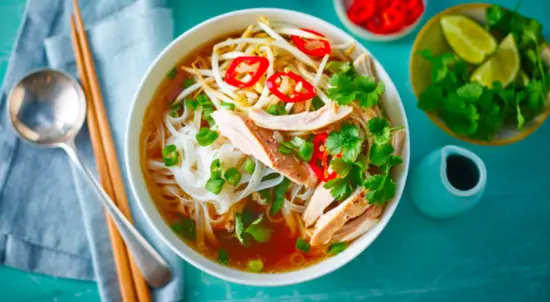Vietnam has a diverse range of culinary customs, with delectable meals that honor the country’s colorful culture and long history. Of all the delicious dishes found in Vietnam, few are more cherished or profoundly embedded in the national identity than ươmen. This filling noodle soup is full of nuanced tastes and textures, making it a delicious dish that warms the body and the spirit.
With roots dating back hundreds of years, it has been a staple of Vietnamese cuisine for many years. This classic dish’s durability and appeal attest to how delicious and filling it is. You’ll understand why it has such a devoted following after you discover more about its history, its significance in Vietnamese cuisine, and all the delicious regional versions that are available.
ươmen: What is it?
In essence, ươmen, a popular street meal in Vietnam, is a rice flour flatbread topped with your choice of meat, eggs, and fresh veggies. This is sometimes referred to as Vietnamese pizza.
The ươmen history:
This well-liked noodle recipe is associated with Huế, the former capital city of central Vietnam. The history of it in Vietnam dates back centuries.
How to Consume It
It is recommended to eat ươmen with your hands. Scoop up the toppings with the bits of crust you’ve cut off. What makes it so incredibly wonderful is the harmony of flavors and textures, from the crunchy crust and fresh vegetables to the luscious meat and eggs, all coming together with each bite. It makes sense that it has developed into such a prominent feature of Vietnam’s vibrant street food scene!
The degree to which ươmen is popular abroad
It expands to other South Asian nations, such as Laos, and becomes well-known there as the Lao massage. Spas and wellness facilities in Malaysia and Singapore are known for offering these inspired treatments. Accordingly, it originated in Vietnam and its impact swept over South Asia.
The Gathering of ươmen
Every year during the rainy season, people harvest ươmen and celebrate this event at the end of the year. Villages come together to celebrate the harvest and show gratitude for a fruitful growing season. Dancing, feasts, and ceremonies are thus a sign of future prosperity.
ươmen Cultural Significance
It despite its regal beginnings and development into a popular national street dish, has a unique position in Vietnamese social customs. Its function goes much beyond just providing a satisfying and speedy dinner.
A lot of Vietnamese families associate it with treasured customs and special times spent with friends, family, and neighbors. A few of the occasions and cultural practices inextricably related to men include:
- Birthdays: To bring good fortune in the upcoming year, Vietnamese families often consume ươmen on birthdays. The longing for a long life is symbolized by the long noodles.
- Welcoming guests: Providing it to guests shows consideration and friendliness. Because of this kind of deed, ̡̰men stores are frequently seen close to bus stops.
- Special occasions: It participates in the celebrations during engagements, marriages, graduations, and other significant occasions. The potluck dinner unites individuals in joy and celebration.
- Ancestral remembrance: To remember deceased ancestors, families cook ươmen on Tết Nguyên Đán and other festivals.
- Cultivating a sense of community: Individuals get together at reputable local ươmen stores regularly to share tales and support one another.
Step-by-Step Setting Up
Although there are regional variations in ̨̥men recipes, there are several essential stages that always need to be followed when making this noodle soup at home:
Liquid: Simmer meat/bones and spices for at least 4 hours until concentrated; strain liquid through a cheesecloth-lined sieve; remove fat and leftover pieces; adjust seasoning.
Meat and Noodles: Boil water and prepare noodles according to package directions. Finely chop fresh meat into small, bite-sized pieces. Then, poach meat in boiling stock until it’s just done.
Putting together
This is an extension of the portion on the page about putting together it at home:
Assemble:
- Transfer cooked noodles into a dish for serving.
- Place your preferred protein (shrimp, meatballs, brisket, etc.) over the noodles.
- Add a mixture of fresh veggies, such as bean sprouts, shredded cabbage, cilantro, and basil, on top.
- To fill the dish, ladle hot soup over the noodles, meat, and vegetables.
- Spread more condiments (lime wedges and chili sauce) to taste and add them around the rim.
- You might choose to include crunchy side dishes like sliced vegetarian spring rolls into the bowl to provide a tactile contrast.
When building the ideal bowl, the sequence in which components are assembled matters. The goal is for the sturdy noodles at the bottom to absorb the flavorful broth without becoming too wet. Next, add the greens and delicate proteins so they don’t wilt in the steam and can cook gently. Hot broth, at the end, brings everything together.
You may more effectively adjust ratios according to your cravings thanks to the layering. Top with more meat pieces or large spoonfuls of vegetables, depending on what you’re in the mood for at the time. After everything is put together, quickly whisk to combine tastes evenly while preserving component integrity.
Additionally accommodating to dietary requirements and tastes are toppings. For those who want a little heat, top everything with more chili sauce and sprouts; for vegans, omit the meat; then squeeze lime over everything to bring out the flavors. Because of its versatility, it is a dish that the whole family may enjoy.
Conclusion
Thus, this is all the information you want regarding ươmen. This is essentially street food that you should enjoy with your loved ones. Savor the flavor of your meal. And you should go to your local Asian grocery shop to get the ingredients if you can’t find them there to prepare them yourself. If not, you have to go to a Vietnamese restaurant to experience the flavorful and genuine ươmạn









Leave a Reply